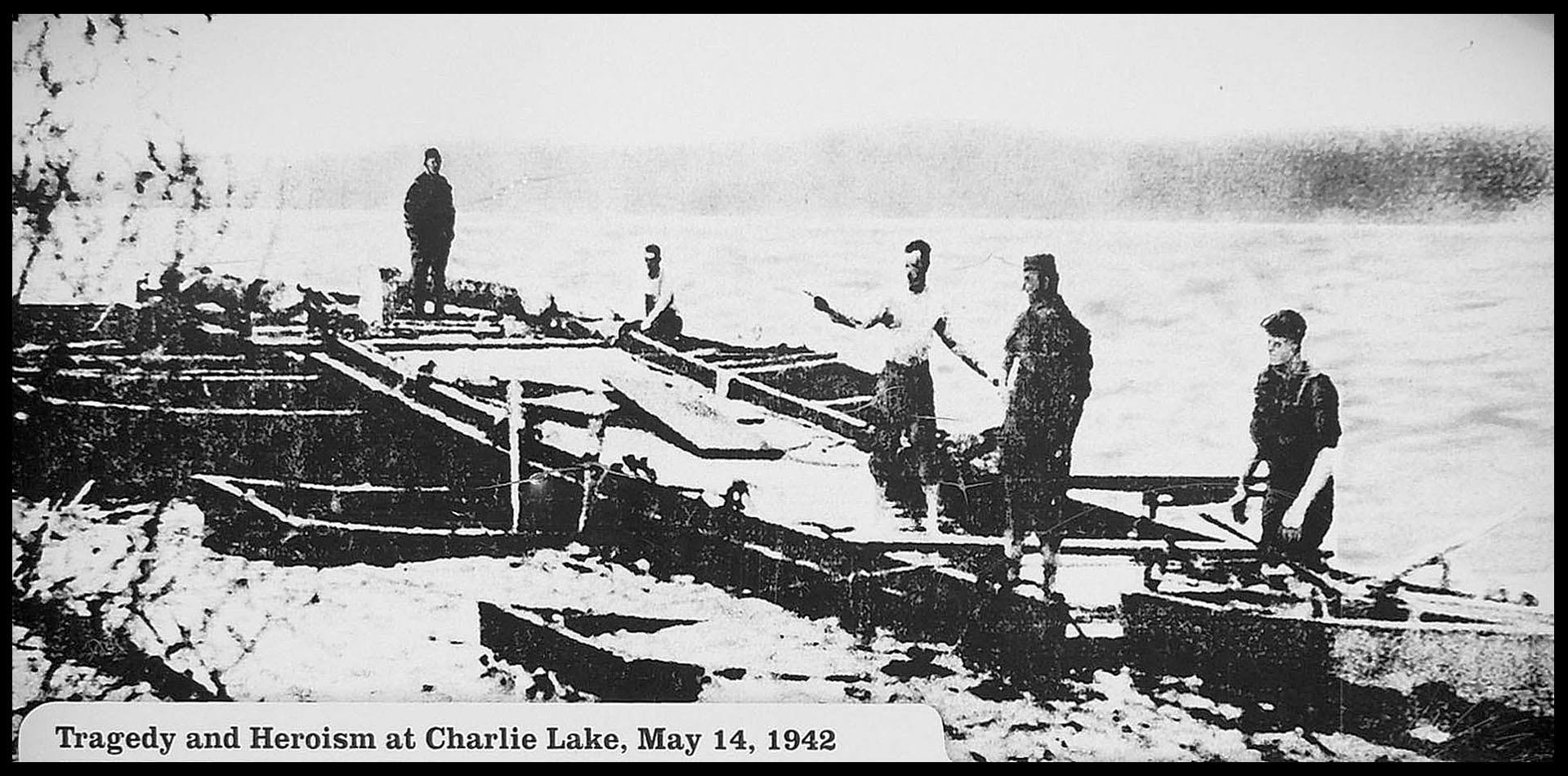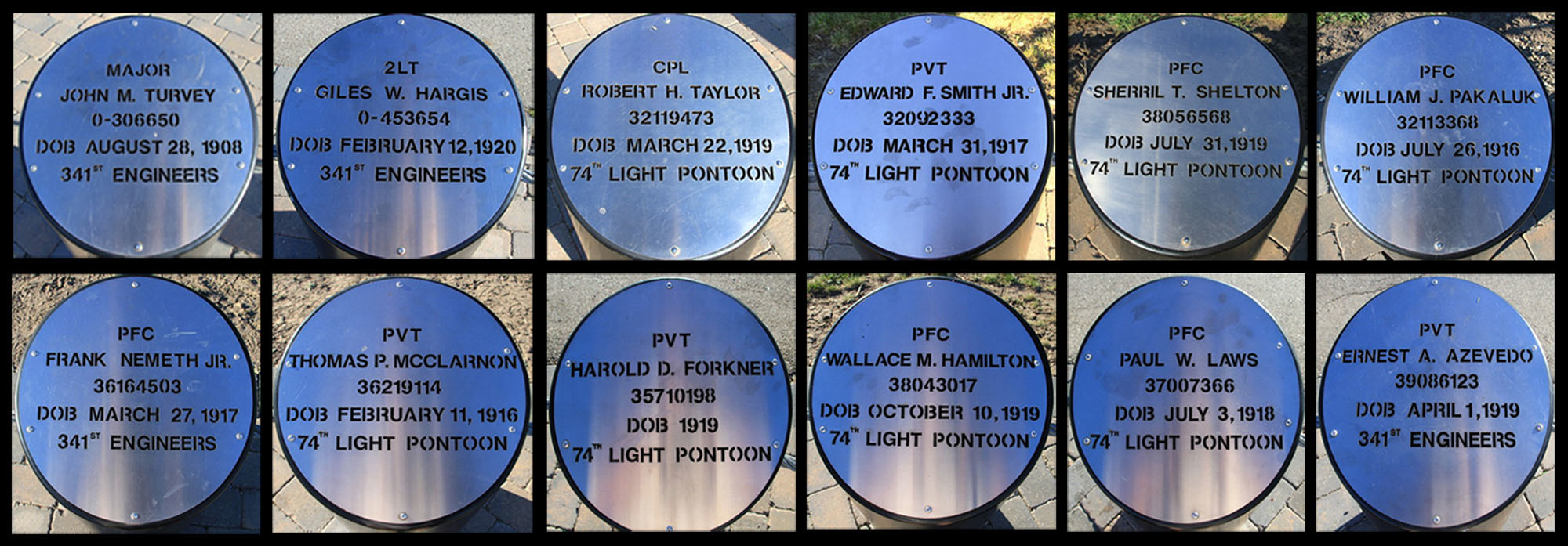Not long after the Japanese attack on Pearl Harbor on Dec. 7, 1941, Alaska became a potential Japanese invasion route to Canada and the United States, so both governments agreed that the road would now be built. Construction began in mid 1942 and about 8 months later it was complete.
Troops of the United States Army Corps of Engineers arrived at Dawson Creek to begin construction of a 2,450 kilometre (1,523 mile) military highway between northern British Columbia and Alaska. At the peak of construction there were over 11,000 soldiers along the route.
The Alaska Highway began at Dawson Creek Mile 0 continued to Charlie Lake Mile Mile 52, BC/Yukon Border Crossing Milepost 627, finally to Delta Junction Milepost 1420.
The monument is a stylized grey upright stone that is quite tall overlooking Charlie Lake not far from where the tragedy happened. It is inscribed as follows:
May 14, 1942
This monument is dedicated to the memory of the United States soldiers lost with the sinking of a US Corp of Engineers Pontoon Barge on May 14, 1942 at Charlie Lake, British Columbia, Canada
Near the monument is a sign with a photograph that explains in detail about the accident and the heroic rescue of five of the solders. Text is transcribed below the photograph.
 Not long after the bombing of Pearl Harbor
Not long after the bombing of Pearl Harbor
on December 7, 1941, President Franklin D. Roosevelt approved a plan to build an inland supply route from
Canada to Alaska. Construction of the Alaska Highway began in March 1942 and brought -nearly 11,000
American soldiers to northern British Columbia, the Yukon, and Alaska. As the work began, many soldiers were stationed
in the Fort St. John area.
Shortly after 8 a.m. on May 14, 1942, a pontoon boat left the 341st Engineer Regiment landing at the
south end of Charlie Lake to deliver equipment, supplies, and personnel to Company E's bivouac site at the north end
of the lake, a distance of about 12 miles (20 km). There were seventeen men on board. Major John Marvin Turvey, in charge
of the expedition, had overseen the loading of the equipment, which included a radio command car, a bulldozer, drums of oil,
and other supplies.
The two-bay, three-boat raft had been built the previous day under the supervision of Lt. John Langendorf, of the 74th Engineer Company. The front compartments of the pontoons were fitted with canvas covers
to keep the water out.
When they started out from the south end of the lake, the water was choppy, with one-foot (0,3 m) waves. Powered by two 22 horsepower motors, the boat proceeded north in increasingly rough water and stronger headwinds, with waves soon reaching two to three feet (0.6-0.9 m). By 11:15 a.m., the boat was about two-thirds of the way to its destination and in the middle of the lake. The men then discovered that a plug had come out of the gas line of one of the motors and gasoline was draining out. They had just rounded the headland when Major Turvey ordered a turn to the west shore. As the boat started to turn, two waves hit it in succession, flooding the right pontoon, which went under, and tipping the raft at a precarious angle. Then it settled and went under, all in less than two minutes.
A mile and a half (2.4 km) away in his cabin on the northwest shore of the lake, homesteader and trapper Gustaf Albin Hedin watched the pontoon ferry making its way up the lake as he cooked his breakfast. He checked its progress through his field glasses, returned to his stove, then checked the lake again. This time, the boat was nowhere to be seen. Instead, he saw men bobbing up and down in the water. Within two minutes, he had launched his 14-foot (4.25 m) rowboat. It took him about 15 minutes to reach the men.
At the accident scene, he found nine men afloat. They were hindered in their own efforts to rescue themselves by their heavy winter clothing and boots. Some of them couldn't swim. He hauled two survivors ashore, then returned to help the others, even though his own small boat was in danger of being swamped by the waves. Two more were rescued during the second trip, and on a third trip, he saved one more man.
The following men were rescued from the freezing waters of Charlie Lake:
PFC Pedro R. Ramirez, 39067026 74th
Engineer Company (Light Pontoon)
PFC Don P. Smethurst, 39081661
74th Engineer Company (Light Pontoon)
Pvt. James G. Eberle, 35170512
74th Engineer Company (Light Pontoon)
Pvt. Daniel P. Galli, 39085932
341st Engineer Regiment
Pvt. Robert 0. Wooldridge, 37048058
341st Engineer Regiment
These twelve men tragically lost their lives May 14, 1942 at Charlie Lake:
2Lt. Giles W. Hargis - 341st Engineers
Cpl. Robert H. Taylor - 74th Light Pontoon
Major John M. Turvey - 341st Engineers
PFC Frank Nemeth, Jr. - 341st Engineers
PFC Paul W. Laws - 74th Light Pontoon
PFC Sherril T. Sheldon - 74th Light Pontoon
PFC Wallace M. Hamilton - 74th Light Pontoon
PFC William J. Pakaluk - 74th Light Pontoon
Pvt. Edward F. Smith, Jr. - 74th Light Pontoon
Pvt. Ernest A. Azevedo - 341st Engineers
Pvt. Harold D. Forkner - 74th Light Pontoon
Pvt. Thomas P. McClarnon - 74th Light Pontoon
A military investigation concluded that the accident was not caused by any misconduct. Gustaf Hedin received a medal from the Humane Society of Canada and was also honored by the Canadian military and the U.S. military
These memorials honor the men who tragically lost their lives on May 14, 1942 at Charlie Lake
